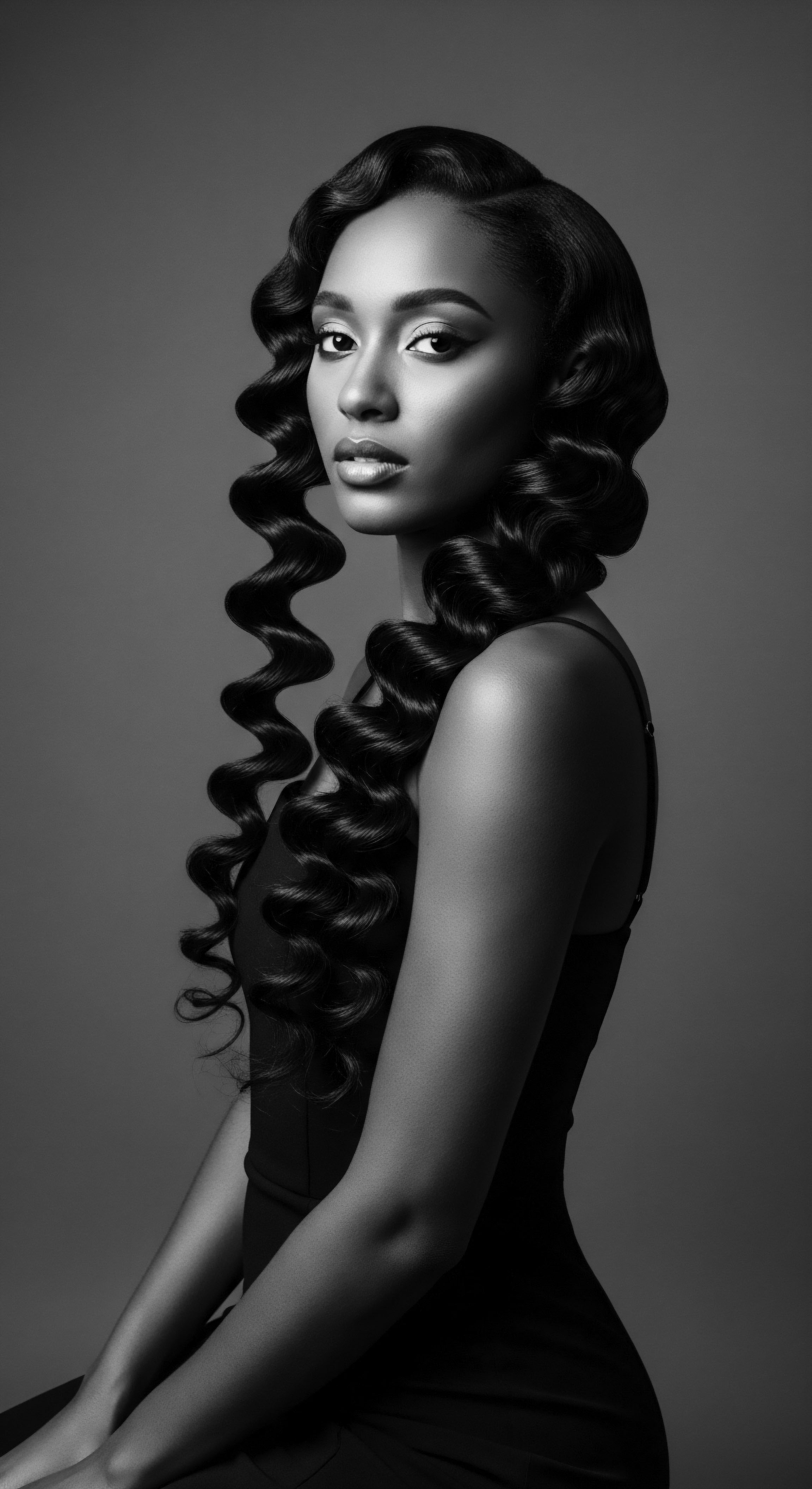
Roots
The story of textured hair, particularly within Black and mixed-race communities, is not merely one of aesthetic choices or personal preference. It is a profound, interwoven chronicle of identity, spirit, and survival. To ask how Jim Crow affected these traditions is to pull back layers of history, revealing not just laws and social mandates, but also the deep, enduring cultural scars and incredible resilience that shaped countless lives.
Our hair, a crown bestowed by ancestry, often served as a visible marker, a silent language spoken without words. It held spiritual meaning, denoted social standing, and communicated lineage in pre-colonial African societies, where elaborate styles could signal marital status, age, religion, or community rank.
But then, across oceans, the brutal machinery of enslavement began its work, and a concerted effort to strip away African identity included the forced shaving of heads. This act severed a physical link to heritage, yet the spirit of traditional practices endured, often in secret, adapted to new realities. As generations passed, these stolen and rebuilt traditions met the stark realities of Jim Crow, a system of laws and societal norms designed to dehumanize and subjugate Black Americans.
In this crucible, the very strands on one’s head became battlegrounds, silent protests, or painful concessions in the unending fight for dignity and survival. The journey of understanding Jim Crow’s reach into textured hair traditions compels us to examine the very fiber of these strands, recognizing them as living archives of heritage and perseverance.
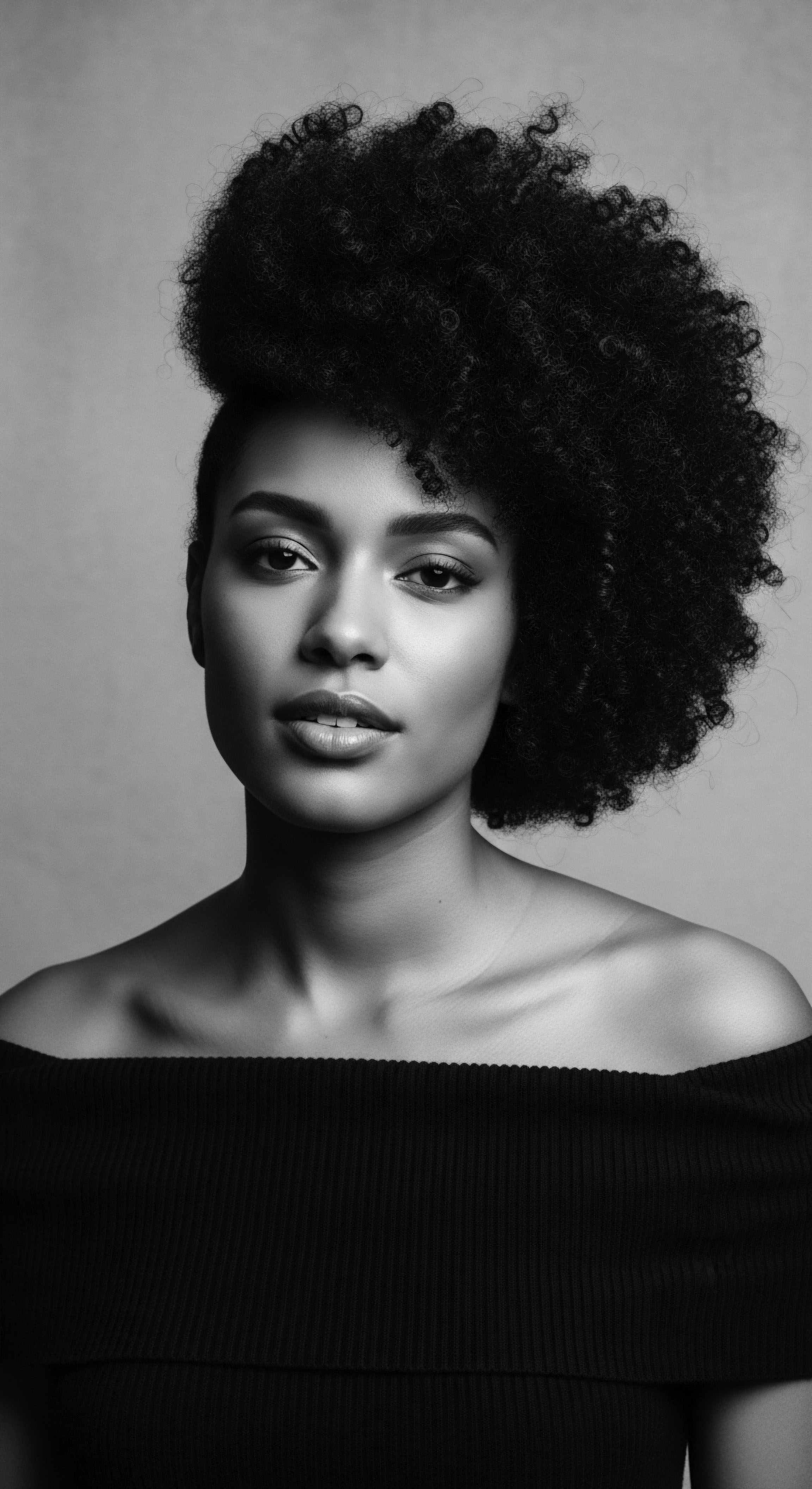
Hair Anatomy and the Ancestral View
At its core, hair is a biological wonder, a protein filament rising from the scalp. For textured hair, its unique helical structure, characterized by tight coils, zigzags, and curls, dictates its strength, elasticity, and vulnerability. The shape of the hair follicle itself, often elliptical or flattened, influences this curl pattern, along with the distribution of keratin within the strand. From an ancestral perspective, this varied anatomy was not a flaw but a blessing, a natural expression of human diversity across the African continent.
Ancient societies held a deep reverence for this biological reality. They understood that different textures required different approaches to care and adornment, and they developed sophisticated methods and tools to honor each unique curl and coil. These practices, passed down through generations, reveal an innate wisdom about textured hair long before modern science offered its classifications.
The Jim Crow era, however, introduced a stark, oppressive lens. Hair that deviated from Eurocentric ideals was deemed “unruly,” “unkempt,” or “nappy,” words weaponized to enforce social hierarchies. This societal pressure had biological consequences ❉ the frequent application of harsh chemical straighteners and excessive heat to alter natural curl patterns often resulted in damage, breakage, and scalp irritation. This shift forced many to move away from gentler, ancestral care methods that prioritized the health and integrity of textured hair, replacing them with practices born of survival and enforced conformity.
The physical characteristics of textured hair, once honored as ancestral blessings, became targets of subjugation under Jim Crow.

Hair Classification and Its Troubled Past
Modern hair classification systems, like the Andre Walker Hair Typing System, categorize hair based on curl patterns, from straight (Type 1) to coily (Type 4). While seemingly objective, these systems have often been critiqued for inheriting biases rooted in historical prejudices. The language used to describe tighter curls has, at times, carried derogatory undertones, linking back to 19th-century taxonomic categories that sought to justify racial hierarchies by classifying African hair as “woolly” or “fleecy.”
Under Jim Crow, the societal value placed on hair directly correlated with its perceived closeness to European hair textures. Lighter skin and straighter hair were often symbols of higher social and economic status within the Black community itself, a painful consequence of systemic racism. This created an internal pressure to conform, where salon practices and product development prioritized chemical and thermal straightening methods. These pressures were not accidental; they were direct outgrowths of a system that demanded outward conformity as a prerequisite for basic social acceptance and economic opportunity.
- Type 1 Hair ❉ Generally straight, often found in European and Asian populations, rarely facing historical discrimination based on texture.
- Type 2 Hair ❉ Wavy patterns, with a gentle S-shape, representing a transition from straight to curly.
- Type 3 Hair ❉ Defined curls, ranging from loose loops to tight spirals, often associated with a higher degree of curl.
- Type 4 Hair ❉ Coily or kinky textures, with very tight, often zig-zag patterns, the primary target of discrimination during Jim Crow.
The legacy of these imposed beauty standards continues to shape perceptions even today, influencing product marketing and individual preferences. It highlights how systems of oppression can warp even the scientific understanding of natural human traits, creating a false hierarchy where none existed ancestrally.

The Essential Lexicon of Hair
Understanding the dialogue around textured hair demands a grasp of its unique vocabulary, which itself carries echoes of historical context. Words like “coil,” “kink,” “curl,” and “strand” describe the physical characteristics. Yet, during Jim Crow, terms like “good hair” versus “bad hair” became common, reflecting the societal pressure to adhere to Eurocentric beauty standards. “Good hair” often referred to hair that was straight or easily straightened, while “bad hair” denoted natural Afro-textured hair.
The adoption of tools like the Hot Comb and chemical Relaxers became widespread as a means of survival and social mobility. These were not merely styling choices; they were often seen as a necessary means to gain employment or avoid harassment. The rise of Black beauty entrepreneurs like Madam C.J.
Walker, while offering economic independence for Black women, simultaneously catered to this demand for straightened hair. Her “Walker System” included hair pomades and hot combs, responding to a deep-seated need for conformity in a hostile society.
| Term Good Hair |
| Common Perception Under Jim Crow Straight, loosely curled, or easily straightened; considered desirable and professional. |
| Ancestral or True Meaning A Eurocentric beauty standard imposed by racist societal norms. |
| Term Bad Hair |
| Common Perception Under Jim Crow Coily, kinky, Afro-textured; considered undesirable, unprofessional, "nappy." |
| Ancestral or True Meaning Refers to hair's natural, unaltered texture, which is a genetic trait of Black and mixed-race individuals. |
| Term Pressing |
| Common Perception Under Jim Crow Temporary straightening using a hot comb, often seen as a step toward acceptance. |
| Ancestral or True Meaning A thermal alteration technique, distinct from permanent chemical changes. |
| Term Relaxer |
| Common Perception Under Jim Crow Chemical treatment to permanently straighten hair, a tool for achieving desired conformity. |
| Ancestral or True Meaning A chemical process that alters the hair's protein structure, originating from a need to survive racial discrimination. |
| Term These terms reflect the profound impact of discriminatory social pressures on the very language used to describe textured hair. |
This historical context underscores how deeply language can be intertwined with power dynamics and how seemingly benign descriptions can carry oppressive weight, shaping perceptions of beauty and self-worth across generations.
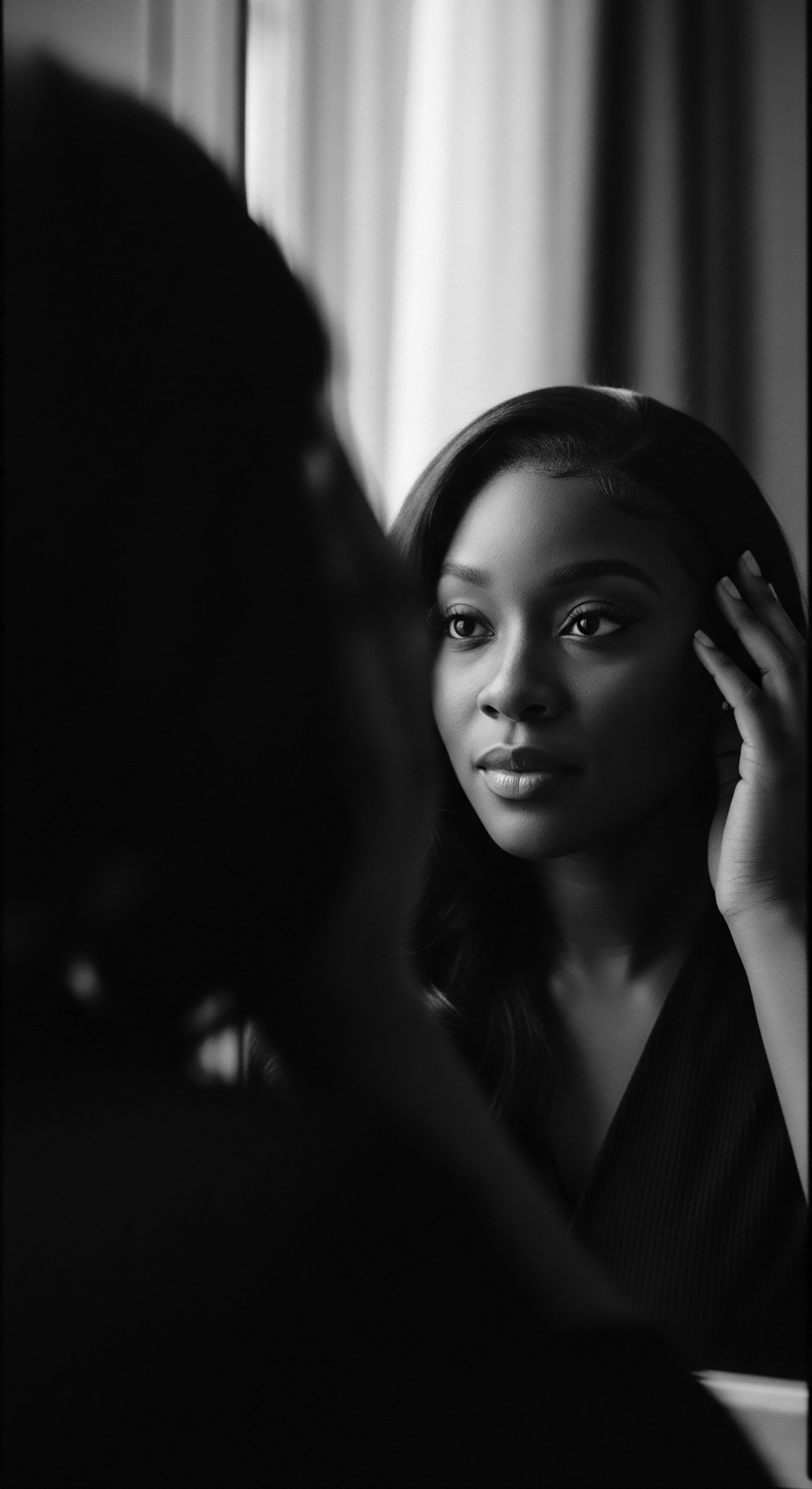
Ritual
The ritual of hair care for Black and mixed-race communities is a living testament to heritage, a spectrum of practices that have shaped identity, fostered community, and quietly resisted oppressive forces across centuries. From ancient African styling as a marker of lineage and status to the adaptive practices born of enslavement, these rituals hold a collective memory. Jim Crow, however, sought to sever this connection, demanding conformity to a singular, imposed aesthetic. The laws and social pressures of the era twisted these intimate traditions, forcing many to abandon ancestral techniques in favor of methods that promised acceptance, often at the cost of hair health and cultural authenticity.

Protective Styling as Heritage and Resistance
Protective styles, such as Braids, Cornrows, and Twists, were not just aesthetic choices in pre-colonial Africa; they were sophisticated forms of cultural expression, often laden with social, spiritual, and even strategic meaning. During the period of enslavement, these traditions continued, sometimes in secret, becoming tools of resistance. Enslaved Africans would conceal seeds within their braids, securing a means of survival for future generations.
Cornrows were even used to map escape routes to freedom. This ancestral ingenuity speaks to the deep heritage embedded within these styling rituals.
The Jim Crow era presented a new, insidious challenge. While direct laws against protective styles were less common than generalized grooming codes, the overarching societal pressure to straighten hair made many traditional styles less viable for those seeking employment or avoiding harassment. The appearance of “respectability” often meant hair that mimicked Eurocentric textures.
This psychological burden, rooted in the constant threat of racial insults, meant that even deeply traditional practices faced immense pressure to adapt or disappear. Blackwelder (2003) notes that “carefully groomed hair and immaculate dress armed women against the arrows of racial insults.” For many, this “grooming” often translated to straightened styles.
The enduring spirit of protective styling, once a vibrant expression of cultural identity, navigated a difficult landscape under Jim Crow, often adapting in the face of imposed beauty norms.

Natural Styling and Definitions ❉ A Hidden Art?
Before and even during the Jim Crow era, natural styling – wearing hair in its inherent texture without chemical alteration – existed, though often in private spaces or specific community contexts. Early photographs and accounts sometimes show individuals with natural curls and coils, particularly in less formal settings or before the pervasive influence of straightening methods took hold. The knowledge of how to care for and define these textures, passed down through generations, often involved natural ingredients and hands-on methods that preserved the hair’s integrity. Shea butter and various natural oils, steeped in African ancestral practice, were vital for moisture and pliability.
How did the prevailing social climate of Jim Crow affect the visibility and practice of natural styling?
The pressures of Jim Crow pushed natural styles into the background of public life. While not explicitly illegal, hair that was not straightened was frequently deemed “unprofessional” or “unacceptable,” making it a barrier to employment, education, and social acceptance. This created a dual reality ❉ while natural hair care might have continued in the intimacy of homes and Black-owned salons, public presentation frequently necessitated altered textures. The cultural definition of “neatness” became synonymous with straightness, suppressing the public expression of natural curls and coils for decades.
The policing of Black hair in schools, for example, has left many Black girls feeling “mentally strained” and “wounded” by the attempts to control their evolving identities. This suggests a continuation of the same pressures felt under Jim Crow.
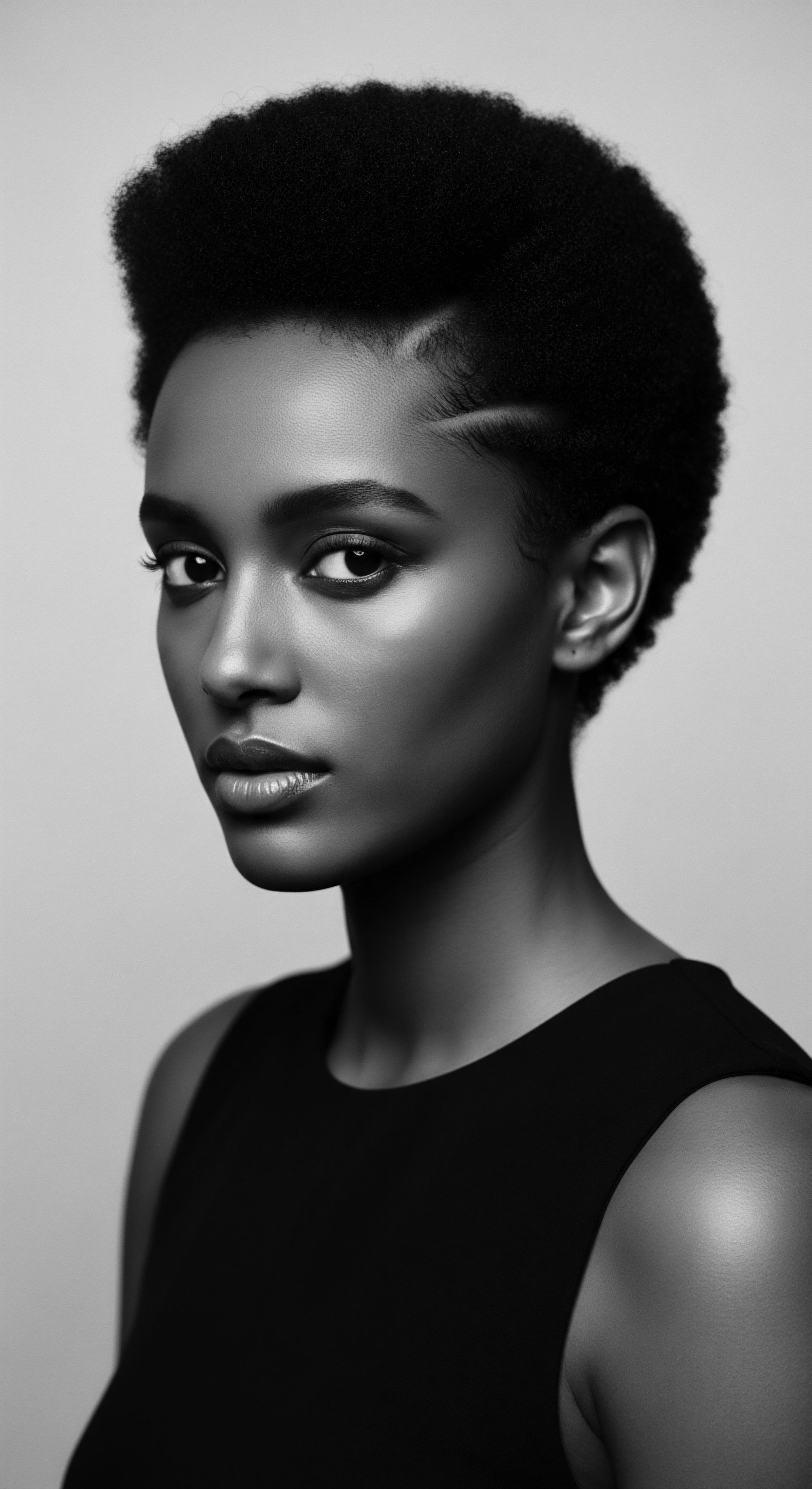
Tools and Thermal Reconditioning ❉ Necessity and Risk
The tools of hair transformation took on amplified significance during Jim Crow. The Hot Comb, patented by innovators like Garrett Morgan in 1913, became a widespread instrument for achieving straight hair. It was a tool of both necessity and adaptation, allowing Black women to conform to the dominant beauty standards that dictated straightened hair as a prerequisite for social and economic participation. Chemical Relaxers also gained immense popularity, offering a more lasting alteration to hair texture.
What were the unseen consequences of widespread thermal and chemical alteration during this period?
The widespread reliance on heat styling and chemical processing carried inherent risks. Repeated exposure to high heat and caustic chemicals could cause significant damage, including breakage, thinning, and chemical burns to the scalp. While these tools provided a means of navigating a discriminatory society, they often came at a cost to hair health. The history of these tools is inseparable from the social context that made them so pervasive.
They stand as a poignant example of how external pressures can influence personal practices, leading individuals to sacrifice the innate health of their hair for a semblance of societal acceptance. The very act of “taming” one’s hair became a loaded performance, fraught with both personal aspiration and systemic coercion.
The proliferation of Black-owned beauty salons during this period became crucial spaces. These salons, often segregated due to Jim Crow laws, provided economic opportunities for Black women and became vital community hubs. They were places where women could gather, share experiences, and support each other, even as they engaged in the often-damaging practices of hair straightening. This duality highlights the complexity of the era ❉ even within systems of oppression, spaces for community, entrepreneurship, and quiet acts of resilience emerged.

Relay
The continuity of care, the passing of wisdom through generations, represents a relay of ancestral knowledge for textured hair. This unbroken chain links ancient practices to modern understanding, a journey interrupted and reshaped, yet never fully severed, by the profound impact of Jim Crow. The system of segregation and discrimination forced Black communities to adapt their care regimens, transforming personal rituals into acts of resistance and survival, all while safeguarding fragments of inherited wisdom. This section delves into how that relay was maintained, how care became a strategic art, and how problems were addressed within a racially oppressive environment.
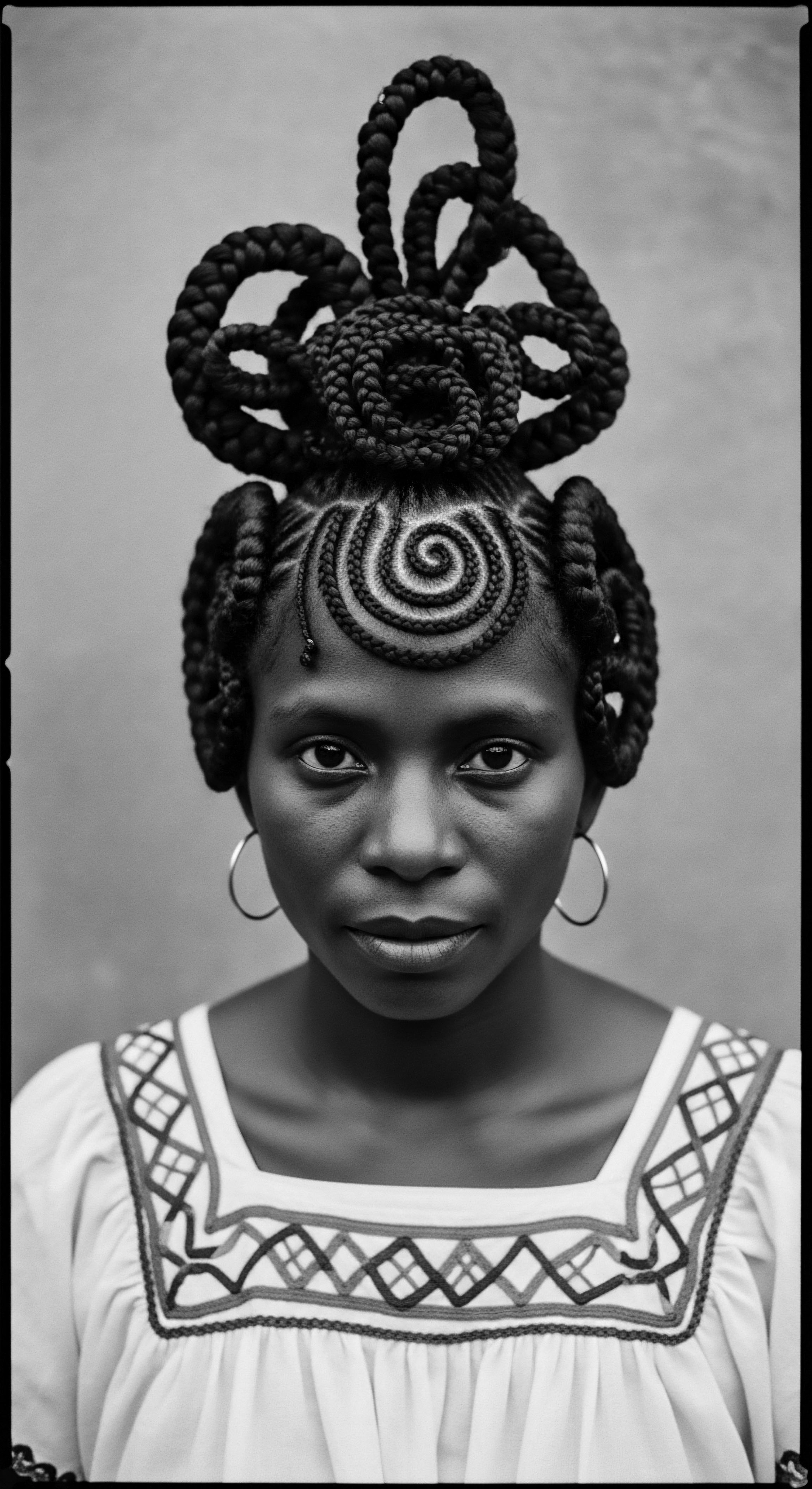
Building Personalized Regimens from Ancestral Wisdom
Before the pervasive influence of Eurocentric beauty standards, traditional African hair care was deeply personalized, reflecting diverse regional practices and local plant knowledge. Ingredients such as Shea Butter, various natural oils, herbs, and even specific clays were utilized for moisture, conditioning, and protection against environmental elements. These traditional methods emphasized hair health, growth, and the creation of intricate styles that often took hours or days to complete, serving as communal bonding experiences. The very act of hair care was a ritual of connection to community and lineage.
Under Jim Crow, the imperative for Black individuals to present a “respectable” appearance, which often meant straightened hair, fundamentally altered these personalized regimens. The focus shifted from nurturing natural texture to altering it, driving a demand for chemical straighteners and pressing combs. The knowledge of ancestral ingredients and natural protective styles was forced underground or confined to the private sphere of the home. This did not extinguish ancestral wisdom, but rather transformed its application.
Families continued to share remedies and techniques for maintaining scalp health amidst the damage from harsh treatments, embodying a quiet defiance. The establishment of beauty parlors run by Black women, like those trained by Madam C.J. Walker and Annie Turnbo Malone, became crucial. These establishments, though often catering to straightened styles, were also havens where Black women could share advice, gossip, and discuss broader social issues, making them centers of community and subtle political activism.

The Nighttime Sanctuary and Bonnet Wisdom
The practice of protecting hair at night is a deeply rooted tradition in textured hair care, extending far beyond the modern invention of the satin bonnet. Ancestrally, various forms of headwraps and coverings were used not only for ceremonial purposes or public presentation but also for practical reasons, including preserving styles and safeguarding hair from environmental factors during sleep. These coverings also provided warmth and spiritual protection.
How did the simple act of nighttime hair protection attain heightened significance during Jim Crow?
During the Jim Crow era, when achieving and maintaining straightened hair was often a social and economic necessity, nighttime protection became even more critical. A well-preserved hairstyle meant less time, effort, and exposure to damaging heat or chemicals during daily upkeep. The Bonnet or Headwrap served as a silent guardian, extending the life of a press or relaxer, and thereby reducing the frequency of potentially harmful treatments. This practice was a practical adaptation to oppressive beauty standards.
It also spoke to a deeper truth ❉ in a world that constantly policed Black bodies and appearances, the private act of protecting one’s hair became a small, yet significant, act of self-care and preservation. It was a space where the demands of the outside world could be momentarily set aside, and the hair, in its temporary state, could find sanctuary.
The enduring custom of head coverings, from elaborate tignons worn by free women of color in antebellum Louisiana (a law passed in 1786 mandated kerchiefs as a symbol of enslaved status, which these women transformed into fashionable adornments) to the widespread use of scarves and bonnets, speaks volumes. These acts were always about more than mere modesty; they were about protecting precious coils and carefully achieved styles, ensuring readiness for a world that judged appearances harshly.

Ingredient Deep Dives for Textured Hair Needs
The science of textured hair, understood through a historical lens, validates many ancestral practices. The unique structure of coiled hair means natural oils from the scalp have a harder time traveling down the hair shaft, leading to a natural propensity for dryness. This biological reality made ancestral practices of applying external moisturizers, like plant butters and oils, incredibly effective.
During Jim Crow, access to quality hair care products for Black individuals was severely limited by segregation. Mainstream beauty brands rarely catered to textured hair, or their products were ineffective or even harmful. This created a fertile ground for Black entrepreneurs and home remedies.
Women like Madam C.J. Walker and Annie Turnbo Malone developed and sold products specifically for Black hair, often incorporating traditional ingredients like petroleum jelly, coconut oil, beeswax, and sulfur, alongside newer chemical formulations.
These formulations, while sometimes including harsh chemicals like lye for straightening, also maintained elements of traditional care, providing conditioning and growth-promoting properties. The dual nature of these products – both conforming to external pressures and addressing specific hair needs – reflects the ingenuity and resilience required to navigate the era. The choice of ingredients was often a balance between desirability (achieving straightness) and necessity (maintaining some level of health).
- Shea Butter ❉ A centuries-old West African ingredient, rich in vitamins and fatty acids, used for deep conditioning and sealing moisture.
- Coconut Oil ❉ A widely used emollient, popular for its ability to penetrate the hair shaft and reduce protein loss, used traditionally in many cultures.
- Castor Oil ❉ Known for its thick consistency and ability to seal in moisture and promote hair growth, often used in ancestral remedies.
- Herbal Infusions ❉ Various herbs, dependent on regional ancestral practices, were used to address scalp health, stimulate growth, and add sheen.
The continuity of using these natural ingredients, despite the overwhelming push for chemical alteration, speaks to the enduring wisdom of ancestral practices and their inherent benefit to textured hair.
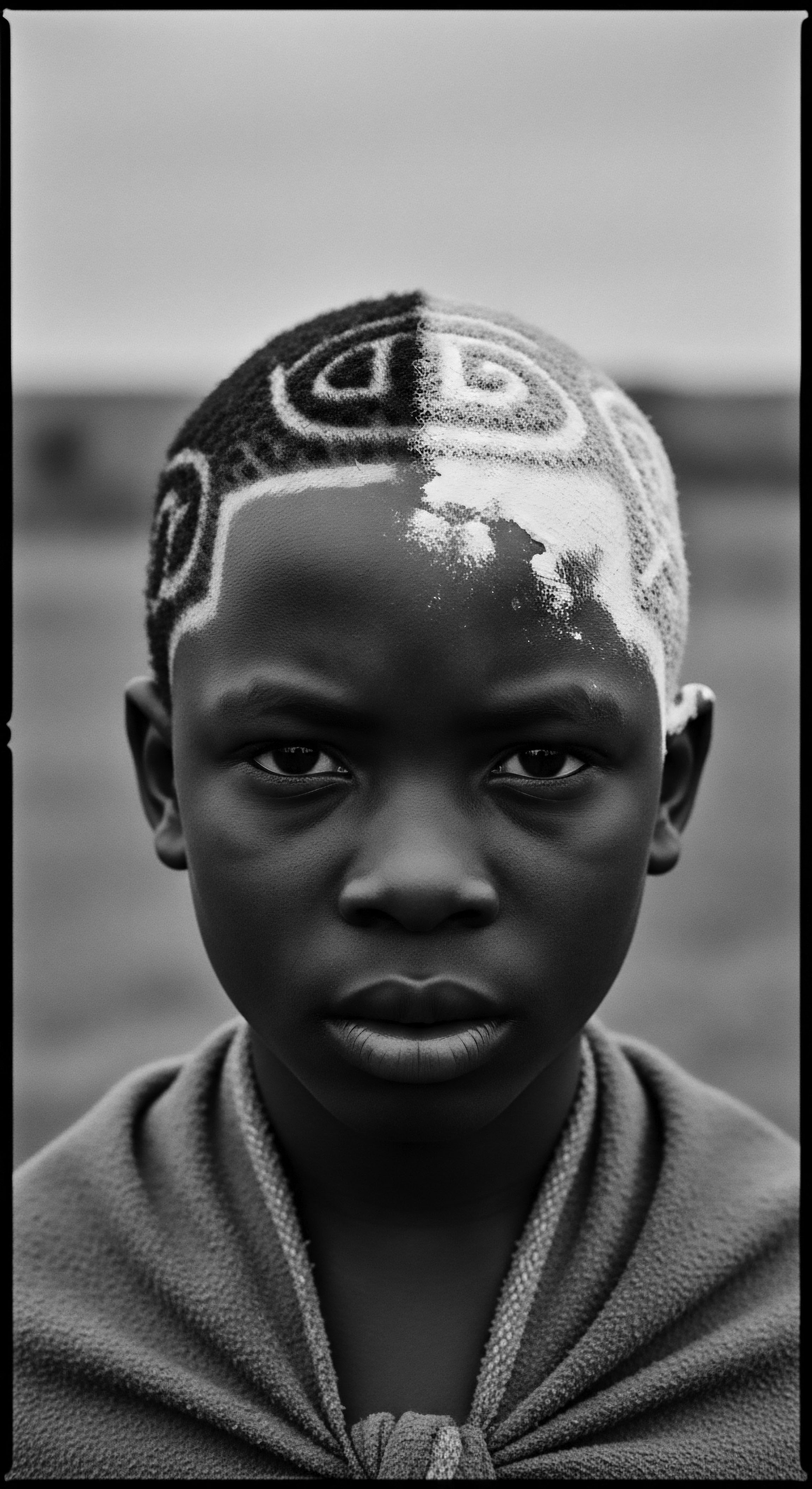
Holistic Influences on Hair Health ❉ Beyond the Strand
Ancestral wellness philosophies understood hair health as intrinsically linked to overall well-being – mind, body, and spirit. This holistic view considered diet, community support, spiritual practices, and even emotional states as contributing factors to the vitality of one’s hair. This worldview contrasts sharply with a more reductionist, Western approach that often isolates hair as merely an aesthetic feature.
How did the psychological toll of Jim Crow manifest in the hair care practices and experiences of Black individuals?
The psychological impact of Jim Crow was immense, creating chronic stress from constant racial insults, economic suppression, and threats of violence. This pervasive stress undeniably influenced the physical body, including hair health. Societal pressure to conform led to practices that were physically damaging, yet were undertaken to avoid discrimination in employment and social settings. The very act of having to alter one’s natural appearance for survival can induce internalized racism, where dominant beauty standards are absorbed and accepted as the norm.
| Impact Area Self-Perception |
| Manifestation Under Jim Crow Pressure to straighten hair to be seen as "acceptable" or "professional." |
| Lingering Effects on Heritage Continued bias against natural textured styles in professional settings. |
| Impact Area Economic Access |
| Manifestation Under Jim Crow Requirement of straightened hair for employment and social mobility. |
| Lingering Effects on Heritage Persistent hair discrimination in workplaces and schools, leading to calls for legislative protection like the CROWN Act. |
| Impact Area Community Bonds |
| Manifestation Under Jim Crow Beauty salons became vital, segregated spaces for support and activism. |
| Lingering Effects on Heritage The salon remains a cultural touchstone, a place of shared identity and intergenerational learning. |
| Impact Area Mental Well-being |
| Manifestation Under Jim Crow Psychological distress from hair policing and forced conformity. |
| Lingering Effects on Heritage Ongoing trauma and internalized biases surrounding textured hair, requiring conscious decolonization of beauty standards. |
| Impact Area The far-reaching consequences of Jim Crow deeply imprinted themselves upon the relationship between Black individuals and their hair, shaping choices and perceptions for generations. |
Yet, within this oppressive framework, the holistic approach to hair care often persisted as an act of quiet rebellion. The community support found in beauty salons, the shared knowledge of remedies, and the continued connection to ancestral roots through practices like hair wrapping (even if modified) became crucial for mental resilience. These acts affirmed a collective identity and beauty that the larger society refused to acknowledge. The psychological strength cultivated in these spaces became as vital to hair health as any product applied to the strand.
The silent strength of community and ancestral wisdom provided a counter-narrative to the oppressive dictates of Jim Crow, allowing a fragile heritage of holistic hair care to persevere.
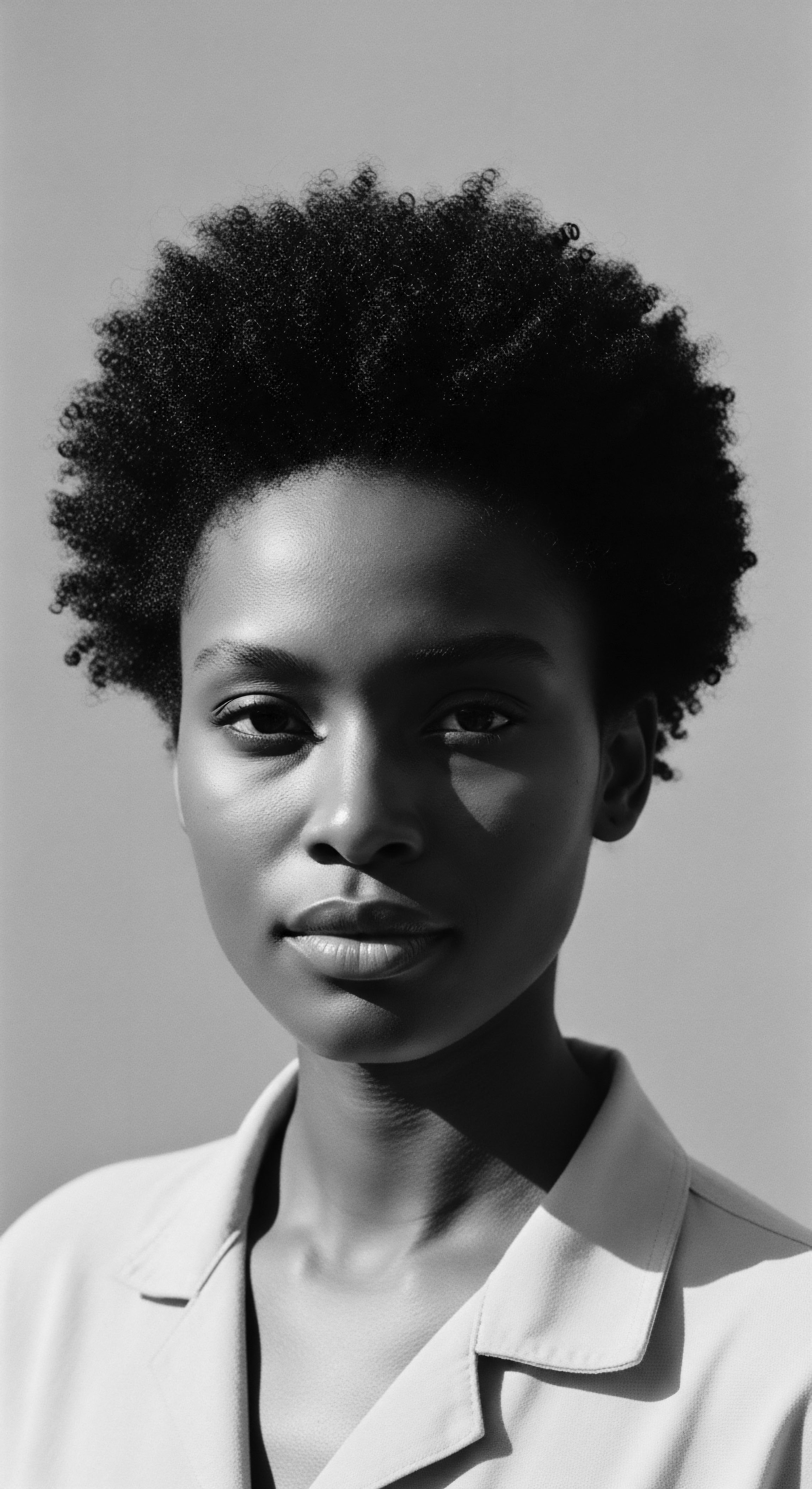
Reflection
The indelible markings of Jim Crow upon textured hair traditions cast long shadows, yet they also illuminate the radiant, unbroken spirit of a people. Our exploration has traced how a system of legalized racial terror reached into the very fibers of Black and mixed-race hair, seeking to erase heritage and impose a singular, Eurocentric vision of beauty. From the coerced alterations of natural coils for basic survival and economic access to the psychological burden of constant policing, the era’s impact was profound.
We saw how the forced adoption of straightening methods, while often physically damaging, became a grim necessity for many navigating a hostile world. The deep ancestral knowledge of hair’s anatomy, once celebrated as a diverse expression of human design, was twisted into a marker of inferiority, demanding conformity to a beauty standard that denied its very existence.
Yet, the story does not end there. It pauses to listen for the whispers of resilience, the quiet acts of preservation, and the defiant glimmers of self-acceptance that persisted through it all. In the intimate spaces of Black homes and segregated salons, a powerful counter-narrative was meticulously crafted. Here, the tender touch of a mother braiding her child’s hair, the shared laughter over a styling session, the communal exchange of remedies for scalp health – these became sacred rituals, preserving cultural memory and ancestral wisdom against tremendous odds.
The ingenuity of Black entrepreneurs, building beauty empires despite systemic barriers, stands as a testament to this unwavering spirit. They carved out spaces where care, commerce, and community intertwined, offering both a means to survive and a platform for collective strength.
The journey of textured hair through the crucible of Jim Crow is a living, breathing archive, a testament to the ‘Soul of a Strand.’ Each coil, each kink, carries the echoes of struggle, adaptation, and profound endurance. Understanding this past does not bind us to its pain; rather, it frees us to fully appreciate the heritage that defines us. It calls us to honor the wisdom passed down, to celebrate the innate beauty of every texture, and to continue the ongoing work of reclaiming and redefining our standards of splendor, always rooted in the deep well of our collective history. The strands on our heads are not simply biological structures; they are storytellers, chronicling a powerful lineage of defiance and radiant self-possession.

References
- Blackwelder, Julia Kirk. Styling Jim Crow ❉ African American Beauty Training during Segregation. Texas A&M University Press, 2003.
- Duggins-Clay, Paige, and Makiah Lyons. “My Hair is Professional Too! ❉ A Case Study and Overview of Laws Pertaining to Workplace Grooming Standards and Hairstyles Akin to African Culture.” Southern Journal of Policy and Justice.
- Everett, Ella. “Tignon Law.” 1966.
- Forbes, Christine, and Oluwatobi Odugunwa. “The History Behind The Silk Press.” Byrdie, 2022.
- Griffin, L. “Untangling Discrimination ❉ The CROWN Act and Protecting Black Hair.” University of Cincinnati Law Review, 2019.
- Hamilton, Ayana. “Untangling Discrimination ❉ The CROWN Act and Protecting Black Hair.” University of Cincinnati Law Review, 2021.
- Kempf, Jennifer A. et al. “Prevalence and Impact of Hair Discrimination.” 2024.
- Lasisi, Tina. “Untangling Race From Hair.” Sapiens.org, 2022.
- Mitchell, Holly J. “The CROWN Act (Creating a Respectful and Open Workplace for Natural Hair Act).” California, 2019.
- Peebles, Nyah. “The Evolution of Black Hair.” HBCU Buzz, 2023.
- Porter, Crystal. “Shape Variability and Classification of Human Hair ❉ A Worldwide Approach.” ResearchGate, 2015.
- Stroyer, Jacob. Interview with Federal Writer’s Project. In White, Shane and Graham White. Styling Jim Crow ❉ African American Beauty Training during Segregation. Texas A&M University Press, 1995.
- Suggs, Cynthia. “Movements for Natural Hair Acceptance Across Time.” 2021.
- Tharps, Lori. Hair Story ❉ Untangling the Roots of Black Hair in America. St. Martin’s Publishing, 2021.
- Young, Venetta. “Black Women in American Society have been victimized by their status as Blacks and as women.”
